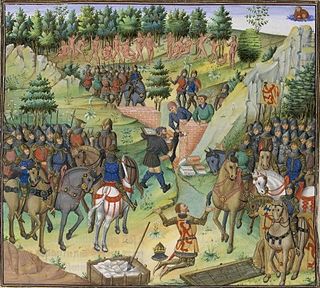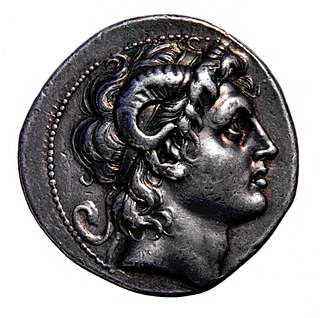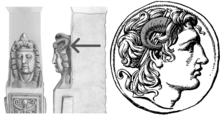
Gog and Magog or Yajuj and Majuj are a pair of names that appear in the Bible and the Quran, variously ascribed to individuals, tribes, or lands. In Ezekiel 38, Gog is an individual and Magog is his land. By the time of the New Testament's Revelation 20, Jewish tradition had long since changed Ezekiel's "Gog from Magog" into "Gog and Magog".

The story of Dhu al-Qarnayn is mentioned in Surah al-Kahf of the Quran. It has long been recognised in modern scholarship that the story of Dhu al-Qarnayn has strong similarities with the Syriac Legend of Alexander the Great. According to this legend, Alexander travelled to the ends of the world then built a wall in the Caucasus mountains to keep Gog and Magog out of civilized lands.

Dhu al-Qarnayn, appears in the Quran, Surah al-Kahf (18), Ayahs 83–101 as one who travels to east and west and sets up a barrier between a certain people and Gog and Magog. Elsewhere, the Quran tells how the end of the world will be signaled by the release of Gog and Magog from behind the barrier. Other apocalyptic writings predict that their destruction by God in a single night will usher in the Day of Resurrection.

The Alexander Romance, once described as "antiquity's most successful novel", is an account of the life and exploits of Alexander the Great. The Romance describes Alexander the Great from his birth, to his succession of the throne of Macedon, his conquests including that of the Persian Empire, and finally his death. Although constructed around an historical core, the romance is mostly fantastical, including many miraculous tales and encounters with mythical creatures such as sirens or centaurs. In this context, the term Romance refers not to the meaning of the word in modern times but in the Old French sense of a novel or roman, a "lengthy prose narrative of a complex and fictional character".

The Gates of Alexander, also known as the Caspian Gates, are one of several mountain passes in eastern Anatolia, the Caucasus, and Persia separating the Greco-Roman world from the Persian world. They are often imagined as an actual fortification, or as a symbolic boundary separating the civilized from the uncivilized world. The original Gates of Alexander were just south of the Caspian Sea, at Rhagae, where Alexander crossed while pursuing Darius III. The name was transferred to passes through the Caucasus, on the other side of the Caspian, by the more fanciful historians of Alexander.

Hikayat Iskandar Zulkarnain is a Malay epic in the tradition of the Alexander Romance describing fictional exploits of Alexander the Great (Iskandar), identified with Dhu al-Qarnayn (Zulkarnain), a king briefly mentioned in the Quran. The oldest existing manuscript is dated 1713, but is in a poor state. Another manuscript was copied by Muhammad Cing Sa'idullah about 1830.
Amun was a major ancient Egyptian deity who appears as a member of the Hermopolitan Ogdoad. Amun was attested from the Old Kingdom together with his wife Amunet. With the 11th Dynasty, Amun rose to the position of patron deity of Thebes by replacing Montu.

Deities depicted with horns or antlers are found in many religions across the world. In religions that venerate animal deities, horned bulls, goats, and rams may be worshiped as deities or serve as the inspiration for a deity's appearance. Many pagan religions include horned gods in their pantheons, such as Pan in Greek mythology and Ikenga in Odinala. Some neopagan religions have constructed these deities as the Horned God, representing the male part of their duotheistic theological system.

The vast conquests of the Macedonian king Alexander the Great quickly inspired the formation and diffusion of legendary material about his deity, journeys, and tales. These appeared shortly after his death, and some may have already begun forming during his lifetime. Common themes and symbols, among legends about Alexander include the Gates of Alexander, the Horns of Alexander, and the Gordian Knot.
The Syriac Alexander Legend, is a Syriac legendary account of the exploits of Alexander the Great composed in the sixth or seventh century. For the first time in this text, the motifs of Alexander's gate, an apocalyptic incursion, and the barbarian tribes of Gog and Magog are fused into a single narrative. The Legend would go on to influence Syriac literature about Alexander, like in the Song of Alexander. It would also exert a strong influence on subsequent apocalyptic literature, like the Apocalypse of Pseudo-Methodius composed in the late seventh century. In Quranic studies, the representation of Alexander in the Legend is also seen as closely related to the Quranic figure named Dhu al-Qarnayn.

The horns of Ammon were curling ram horns, used as a symbol of the Egyptian deity Ammon. Because of the visual similarity, they were also associated with the fossils shells of ancient snails and cephalopods, the latter now known as ammonite because of that historical connection.
Ṣaʿb Dhu Marāthid was a mythical figure described in the medieval Islamic tradition as the tenth South Arabian king of the Himyarite Kingdom.

Alexander the Great was a king of ancient Greece and Macedon who forged one of the largest empires in world history. Soon after his death, a body of legend began to accumulate about his life and exploits. With the Greek Alexander Romance and its translation into numerous languages including Armenian, Syriac, Arabic, Persian, Ethiopic, and more, an entire genre of literature was dedicated to the exploits of Alexander in both Christian and Muslim realms. Alexander was also the one most frequently identified with Dhu al-Qarnayn, a figure that appears in Surah Al-Kahf in the Quran, the holy text of Islam, which greatly expanded the attention paid to him in the traditions of the Muslim world.
The Qiṣṣat Dhī ʾl-Qarnayn is a Hispano-Arabic legend of Alexander the Great preserved in two fourteenth-century manuscripts in Madrid and likely dates as a ninth-century Arabic translation of the Syriac Alexander Legend produced in Al-Andalus. In this respect, it is similar to the Hadīth Dhī ʾl-Qarnayn and is an example of the literary genre of Qisas al-Anbiya. It is to be distinguished from another text also known as the Qissat Dhulqarnayn found in the book of prophets by al-Tha'labi as well as the Qiṣṣat al-Iskandar, a text dating to the late eighth or early ninth century representing the earliest translation of the Alexander Romance into Arabic. The Qissat depicts the travels of Alexander whom it identifies with the figure named Dhu al-Qarnayn in Surah al-Kahf of the Quran, referred to as Dhulqarnayn in the text. The Qissat depicts Alexander (Dhulqarnayn) as a faithful believer and as a proto-Muslim who spreads monotheism through his conquests. It combines elements of pre-Islamic Alexander legends in addition to novel traditions developed in the oral Arab-Islamic tradition. Using the Islamic citation method of isnad, the text prefaces each narrative episode with a chain of transmitters that root in one of Muhammad's companions. Its primary transmitters are given as Ka'b al-Ahbar, Ibn 'Abbas, Muqatil ibn Sulayman, 'Abd al-Malik al-Mashuni, and 'Abd al-Malik b. Zayd. An English translation of the Qissat Dhulqarnayn was first produced by David Zuwiyya in 2001.
The Qiṣṣat al-Iskandar is the earliest narrative of Alexander the Great in the tradition of the Alexander Romance genre in the Arabic language. It was composed by ‘Umara ibn Zayd (767-815) between the late 8th to the early 9th century as a recension on the Syriac Alexander Legend. It is not to be confused with the Qissat Dhulqarnayn or the Sirat al-Iskandar.
The Iskandarnameh, not to be confused with the Iskandarnameh of Nizami, is the oldest Persian recension of the Alexander Romance tradition, anonymous and dated to some time between the eleventh and fourteenth centuries, although recently its compilation has been placed in the eleventh century by Evangelos Venetis, during the reign of Mahmud of Ghazni in the court of the Ghaznavid Empire. This may have been followed by two stages of recompilation which helped to propagate the mode of rulership of Mahmud. Alexander is described as a Muslim king and prophet and is identified with the conqueror named Dhu al-Qarnayn in the Quran. This identification is also witnessed in the Arabic recensions of the Alexander romance, such as the Qissat al-Iskandar and the Qissat Dhulqarnayn. As such, he is double-horned and builds the famous Gates of Alexander against Gog and Magog.
The Hadīth Dhī ʾl-Qarnayn, also known as the Leyenda de Alejandro, is an anonymous Hispano-Arabic legend of Alexander the Great. It dates to the 15th century.
Alexander the Great was the king of the Kingdom of Macedon and the founder of an empire that stretched from Greece to northwestern India. Legends surrounding his life quickly sprung up soon after his own death. His predecessors represented him in their coinage as the son of Zeus Ammon, wearing what would become the Horns of Alexander as originally signified by the Horns of Ammon. Legends of Alexander's exploits coalesced into the third-century Alexander Romance which, in the premodern period, went through over one hundred recensions, translations, and derivations and was translated into almost every European vernacular and every language of the Islamic world. After the Bible, it was the most popular form of European literature. It was also translated into every language from the Islamicized regions of Asia and Africa, from Mali to Malaysia.
The Ethiopic Alexander Romance, also known as the Ethiopic Pseudo-Callisthenes or the Zēnā Eskender, is the work of an anonymous Christian and is the most important version of the Alexander Romance in the Geʽez language and the Ethiopian tradition. It was translated in the fourteenth century from an Arabic version of the Romance, which itself was translated from the earlier Syriac Alexander Romance. Although it originates from these sources, it does not follow their three-book structure. The text retains the essential plot from earlier romances, and is a witness to common motifs of Alexander such as his horns.







